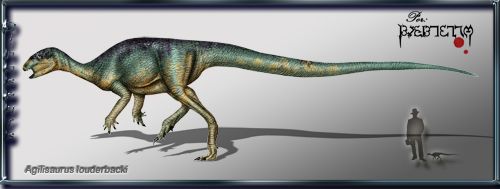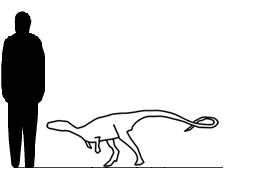[Recent Entries][Archive][Friends][User Info]
| May 29th, 2012 | |
|---|---|
| 07:03 pm [industrialterro] [Link] |
Agilisaurus Агилизавр (Agilisaurus) — род вымерших птицетазовых динозавров из группы Neornithischia, живших в среднем юрском периоде (около 171,6—167,7 миллионов лет назад), на территории нынешней Азии. Окаменелости были найдены в провинции Сычуань в Китае. Впервые описан палеонтологом Пенгом в 1990 году. Представлен одним видом — Agilisaurus louderbacki. Хотя агилизавр известен по почти полному скелету, его фактическое положение в эволюционной иерархии динозавров до сих пор остается неясным. Пол Барретт из Лондонского музея естественной истории, считает, что он слишком примитивен, чтобы отнести его к традиционным орнитоподам. Возможно, это фаброзаурид, один из очень примитивных орнитопод, еще не имевших защечных пазух, но не исключено, что он является представителем совершенно нового семейства. Череп агилизавра маленький, с большими глазами, его зубы имеют форму листьев. Зубы крупные, в передней части они заострены. Задние конечности гораздо длиннее передних. Бедренная кость кажется особенно короткой по сравнению с остальными костями ног: признак быстро бегающего животного с легкой стопой и мускулами, сосредоточенными у бедра. Длинный хвост использовался для баланса при беге. Agilisaurus ('agile lizard') is a genus of ornithischian dinosaur from the Middle Jurassic Period of what is now eastern Asia. The name is derived from the Latin agilis meaning 'agile' and the Greek sauros meaning 'lizard', and refers to the agility suggested by its lightweight skeleton and long legs. Its tibia (lower leg bone) was longer than its femur (upper leg bone), which indicates that it was an extremely fast bipedal runner, using its long tail for balance, although it may have walked on all fours when browsing for food. It was a small herbivore, about 1.2 meters (4 feet) in length, and like all ornithischians, it had a beak-like structure on the ends of both upper and lower jaws to help it crop plant material. Despite its completeness, Agilisaurus has been placed in many different positions in the ornithischian family tree. It was originally placed in the family Fabrosauridae, which is no longer considered valid by most paleontologists (Peng 1990). Several recent studies, including cladistic analyses, find Agilisaurus to be the most basal member of the group Euornithopoda, which includes all ornithopods more derived than the family Heterodontosauridae (Weishampel et al. 2003; Norman et al. 2004). However, heterodontosaurs are not universally considered to be ornithopods and have been considered more closely related to the suborder Marginocephalia, which includes ceratopsians and pachycephalosaurs. In one recent cladistic analysis, Agilisaurus was found in a position basal to heterodontosaurs in the branch leading to Marginocephalia (Xu et al. 2006). Agilisaurus has been recovered in other positions as well, including as an ornithischian basal to both ornithopods and marginocephalians (Barrett et al. 2005; Butler 2005; Butler et al. 2008). Comparisons between the scleral rings of Agilisaurus and modern birds and reptiles suggest that it may have been diurnal, unlike larger herbivorous dinosaurs that were inferred to be cathemeral, active throughout the day at short intervals. Neornithischia ("new ornithischians") is a clade of the dinosaur order Ornithischia. They are the sister group of the Thyreophora within the clade Genasauria. Neornithischians are united by having a thicker layer of asymmetrical enamel on the inside of their lower teeth. The teeth wore unevenly with chewing and developed sharp ridges that allowed neornithischians to break down tougher plant food than other dinosaurs.
Размеры тела в сравнении с человеком:
Tags: Вымершие рептилии, Юра, авеметатарзалии, архозавроморфы, архозавры, диапсиды, динозавроморфы, динозавры, неорнитискии, птицетазовые |







